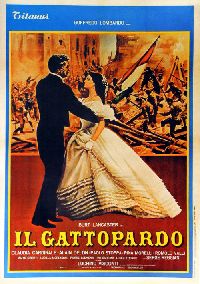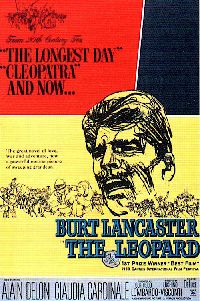|
|
 | Il Gattopardo |  |
|
| Le Guépard; Il Gattopardo
|
| Italia - Francia 1963 - 178 Min. |
| Mostra i titoli internazionali |
 |
| Sommario |
|
The wealthy Prince Fabrizio of Salina is facing difficult times. Garibaldi's revolutionary followers, who wanted to force the unification of Italy, have arrived in Sicily and the Prince is convinced that this development can no longer be stopped. Therefore, he accepts the changes, but without actively supporting them. His impoverished nephew Tancredi Falconieri, on the other hand, takes advantage of the moment to make a respectable career in the army alongside the revolutionaries. He also gets engaged to the beautiful daughter of the mayor Calogero Sedara, who has earned a lot of money in the new times but who is also longing for social recognition. The film ends with a pompous ball at which Calogero Sedara and his beautiful daughter Angelica are introduced to noble society, while Prince Fabrizio melancholy looks forward to the new times and is convinced that nothing will change for Sicily.
In this historical drama, Terence Hill plays Count Carlo Cavriaghi, who initially fights alongside Tancredi Falconieri on the side of the revolutionaries, also makes a career in the army and is finally a guest in the house of Salinas to court the Prince's daughter.
The film was a decisive step in the career of the later Terence Hill, because the great success confirmed Terence Hill's decision to give up his studies of literature and philosophy and concentrate fully on acting.
The film is based on the 1958 novel "Il Gattopardo" by Giuseppe Tomasi di Lampedusa. The Prince of Lampedusa takes up his own family history. Lampedusa wrote the novel as early as 1954, but found no interested publisher. Only after his death in 1957 was the quality of the novel recognized and the work was published.
Not only the original novel for the film comes from an Italian nobleman, also the film itself is of aristocratic descent. Director Luchino Visconti also came from the nobility. His full name was Count Don Luchino Visconti di Modrone.
Luchino Visconti is the uncle of Eriprando Visconti. Eriprando Visconti filmed the court drama The True and the False with Terence Hill in 1972.
The budget for the filming was exorbitantly high at that time at 7 million dollar. The money was not only invested in the fees of the stars, but above all in the pompous equipment of the film to give the film a realistic atmosphere.
The famous final dance scene at the big ball in the Prince's house was filmed in a palace with 218 rooms. The ballroom was lit by 2000 wax candles and populated by up to 600 extras. Among the extras were also many counts, barons and baronesses from the Italian nobility to improve the realism. The elaborate costumes of the actors and extras alone cost a fortune, but the rest of the equipment also contributed to the enormous costs. Valuable works of art and paintings were lent from various museums, which subsequently had to be insured very expensively.
The elaborate costumes were created by Piero Tosi, who was nominated for the Oscar for best costume design in 1964.
The ball scene was shot in 57 nights. It could only be shot at night because it was much too hot to work in costumes during the day. Every evening the gigantic food buffet was rebuilt and filled with fresh lobster, spiny lobsters, roasts, cakes and many others.
The music for the film was written by Nino Rota, who takes up themes by Giuseppe Verdi. A waltz by Verdi was also used for the film. The soundtrack was already released on LP in 1963 and then re-released several times both as LP and on CD.
The film won the Golden Palm as best film at the Cannes Film Festival in 1963.
Until 1983, the film was only ever shown in a shortened version in Germany. The film was extensively restored for the Venice Film Festival in 1991. In 1995 the film was shown in German cinemas for the first time in full lenght. The current DVD and Blu-ray releases also contain the restored uncut version.
The shooting began on 15.05.1962 in the streets of Palermo, Ciminna, Villa Boscogrande near Palermo and Palazzo Gangi-Valguarnera, where the famous ball scene was shot.
The original Italian title of the novel and the film is "Il gattopardo". For both the novel and the film this was translated into many languages as "The Leopard". However, this is not correct, because Leopard is called "Leopardo" in Italian. As Gattopardo, a smaller African wildcat is called in Italy, whose English name is "Serval".
Runtimes:
German Blu-ray: 185:27 minutes
|
| Data di uscita: |
| 28.03.1963 |
Italia |
Prima proiezione |
12.850.375 Besucher |
| 14.06.1963 |
Francia |
Prima proiezione |
3.649.498 Besucher |
| 08.11.1963 |
Germania |
Prima proiezione |
490.000 Besucher |
| 14.02.1964 |
Finlandia |
Prima proiezione |
| 07.01.1966 |
Germania |
Prima proiezione |
DDR |
| 10.08.1969 |
Germania |
Prima visione TV |
ARD |
| 25.12.1980 |
Germania |
Prima visione TV |
DDR 2 |
| 13.04.1984 |
Finlandia |
Riedizione |
14.255 Besucher |
| 31.08.1984 |
Germania |
Riedizione |
96.768 Besucher |
|
| Altre immagini dei titoli: |
|
|
 |
| Mostra il sommario aggiuntivo |
 |
| torna su |
 |
| Cast |
|
|
 |
| Mostra la galleria degli interpreti sconosciuti |
 |
| torna su |
 |
| Staff |
| Musica |
| Franco Ferrara (Orcehstra sinfonica di Santa Cecilia diretta da), Giuseppe Verdi (Un valzer inedito di), Nino Rota (Musica di)
|
| Sceneggiatura |
| Enrico Medioli (Adattato e sceneggiato da), Giuseppe Tomasi Di Lampedusa (dal romanzo di), Luchino Visconti (Adattato e sceneggiato da), Massimo Franciosa (Adattato e sceneggiato da), Pasquale Festa Campanile (Adattato e sceneggiato da), Suso Cecchi d'Amico (Adattato e sceneggiato da)
|
| Direttore della fotografia |
| Giuseppe Rotunno (Fotografia di), Nino Cristiani (Operatore alla macchina), Enrico Cignitti (Operatore alla macchina), Giuseppe Maccari (Operatore alla macchina), G.B. Poletto (Fotografo di scena)
|
| Montaggio |
| Mario Serandrei (Montaggio di)
|
| Scenografia |
| Mario Garbuglia (Scenografia di), Giorgio Pes (Arredamento di), Laudomia Hercolani (Arredamento di), Ferdinando Giovannoni (Aiuto architetto), Emilio D'Andria (Aiuto arredatore)
| | Costumi |
| Piero Tosi (Costumi di), Vera Marzot (Aiuto costumista), Bice Brichetto (Aiuto costumista), Alessandro Gasparinetti (Consulente uniformologico)
| | Truccatore |
| Alberto De Rossi (Truccatore)
| | Parrucchiere |
| Maria Angelini (Parrucchiere), Amalia Paoletti (Parrucchiere)
| | Fonico |
| Mario Messina (Tecnico del suono)
| | Segretaria di edizione |
| Stephan Iscovescu (Segretario di edizione)
| | Produzione |
| Titanus S.p.A. (Roma), Société Nouvelle Pathé Cinéma (als S.N. Pathé Cinéma; Parigi), Société Générale de Cinématographie (als S.G.C.; Parigi)
| | Aiuto regista |
| Rinaldo Ricci (Aiuto regista), Albino Cocco (Aiuto regista), Francesco Massaro (Assistente alla regia), Brad Fuller (Assistente alla regia)
|
| Produttore |
| Goffredo Lombardo (presenta), Pietro Notarianni (Realizzazione di), Enzo Provenzale (Direttore di produzione), Giorgio Adriani (Direttore di produzione), Roberto Cocco (Ispettore di produzione), Riccardo Caneva (Ispettore di produzione), Gilberto Scarpellini (Ispettore di produzione), Gaetano Amata (Ispettore di produzione), Bruno Sassaroli (Ispettore di produzione), Umberto Sambuco (Segretario di produzione), Lamberto Pippia (Segretario di produzione)
|
| Regia |
| Luchino Visconti
|
|
| torna su |
 |
| Questo film è disponibile nei seguenti formati |
|
|
| torna su |
 |
| Colonna sonora |
|
|
| torna su |
 |
| Locandine |
Belgio
 |
Germania
 |
Germania
 |
Francia
 |
Francia
 |
Grecia
 |
Gran Bretagna
 |
Italia
 |
Italia
 |
Italia
 |
Italia
 |
Italia
 |
Giappone
 |
Giappone
 |
Giappone
 |
Polonia
 |
Svezia
 |
Spagna
 |
USA
 |
USA
 |
USA
 |
|
|
| torna su |
 |
| Questa pagina è stata visitata 72654. volte. |
| | |
